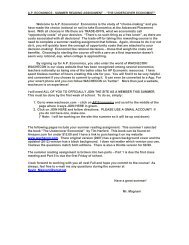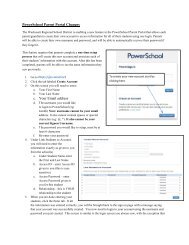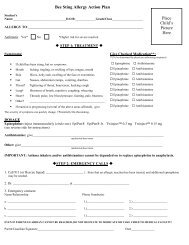(MCAS) ELA Grade 4
(MCAS) ELA Grade 4
(MCAS) ELA Grade 4
You also want an ePaper? Increase the reach of your titles
YUMPU automatically turns print PDFs into web optimized ePapers that Google loves.
English Language Arts<br />
aaSession 1, Reading Selection #2a1<br />
There are many ways that dogs show that they are our friends.<br />
Read the selection below and answer the questions that follow.<br />
From:<br />
Dogs Giving a Hand<br />
by Catherine O’Neill<br />
1<br />
2<br />
3<br />
4<br />
5<br />
As traffic comes to a halt at a busy intersection, a Labrador<br />
retriever steps off the curb. The dog walks confidently to the<br />
other of the street. His owner, a blind college student,<br />
walks side just behind him, holding on to the handle of the dog’s<br />
leather harness.<br />
For the student, owning a well-trained dog guide means<br />
freedom and independence. The student can go to and from<br />
class without depending on anyone else for help.<br />
Working in partnership with a dog guide, a blind person can<br />
go almost anywhere a sighted person can. Together, dog and owner<br />
walk up and down stairs. They board subways and buses. They go to<br />
restaurants. The dog acts as the blind person’s eyes,<br />
guiding its owner safely wherever they go.<br />
Dog guides for the blind are probably the most familiar of the service dogs. But did you<br />
know that dogs also act as ears for the deaf Hearing dogs learn to notice such important sounds<br />
as those made by alarm clocks, doorbells, smoke detectors, sirens, and crying babies. They alert<br />
their owners to a noise, and let them know where the sound is coming from. Dogs can be helpful<br />
partners for physically disabled people, too. At Canine Companions for Independence, in Santa<br />
Rosa, California, dogs learn to respond to 89 commands. These dogs can push elevator buttons<br />
with their paws and pull wheelchairs up steep walkways. They carry their owners’ belongings in<br />
special dogpacks, open and close doors, turn on lights, and even pay for purchases. For some disabled<br />
children, having a canine companion gives them the chance to go places they’ve never gone<br />
before. The dogs often enable adults to take jobs and live on their own for the first time.<br />
At some hospitals and nursing homes, dog visitors actually help improve the physical as well<br />
as the mental health of patients. Researchers have discovered that stroking an animal lowers a<br />
person’s blood pressure. Because high blood pressure can lead to many illnesses, including heart<br />
disease, petting a dog can be good medicine. Some experts think that touching an animal may<br />
release chemicals in the human brain that make people relax and feel good. Some nursing homes<br />
allow elderly residents to keep their own pets. In others, volunteers bring trained “therapy dogs” to<br />
visit on a regular basis. Some of these dogs have worked wonders. The elderly people look forward<br />
to the dogs’ visits. One 90-year-old woman had stopped caring about life. She just stayed in bed.<br />
But once dogs became frequent visitors, she was always up and dressed, eager to greet them.<br />
THE MASSACHUSETTS COMPREHENSIVE ASSESSMENT SYSTEM: 46<br />
Release of Spring 2000, 2001 & 2002 Test Items<br />
Rev. 06/03 srm
















